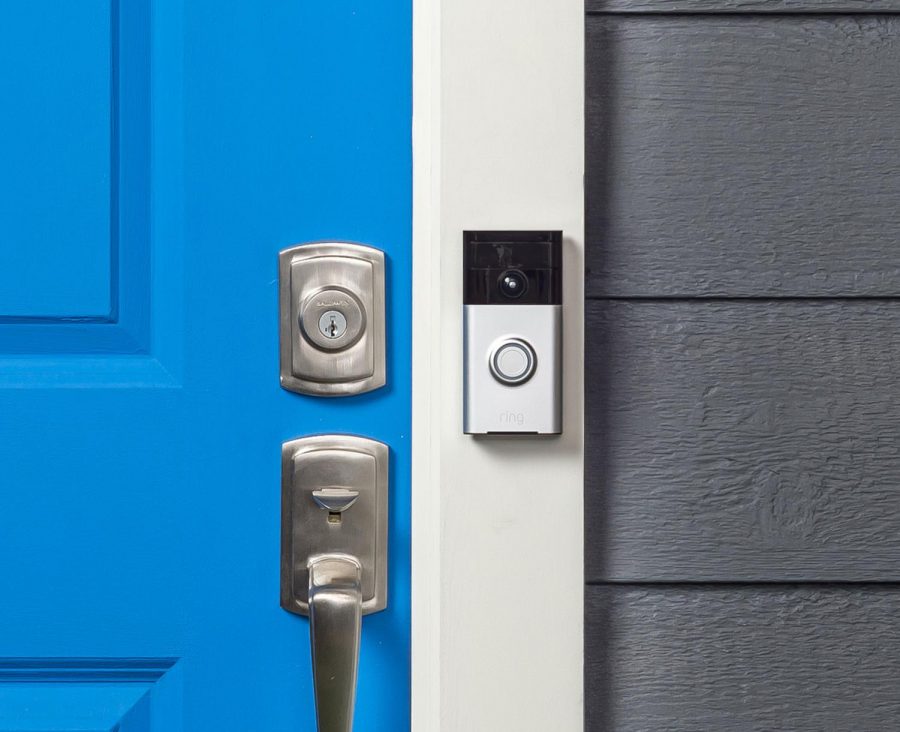Smart doorbells encourage bad habits
The Ring video doorbell, mounted next to the front door of a house.
Feb 18, 2019
While I was volunteering for a congressional candidate in the midterm election, I knocked on doors in neighborhoods around Champaign-Urbana where it seemed nearly every single house had a “smart” doorbell. In retrospect, their prevalence was chilling.
For the uninitiated, smart doorbells — devices like Ring and Nest sold by companies owned by Amazon and Google respectively — are not your mother’s door chimes. They look innocent enough. These small black rectangles feature a button to ring — and a camera. The owners of the home are alerted by phone whenever anyone is at the door and even get a live feed of their guests waiting on the steps.
If you’re reminded of some Orwellian novel, you’re not alone. Civil liberties advocates across the country like the American Civil Liberties Union are unnerved at the prospect that houses now have eyes. The idea behind these bells is they will stop crime on their own, but even well-meaning tools can be abused. They can promote dangerous vigilante crime-stopping at the very best; at worst, they force civilians to comply with police forces, turning neighborhoods into unsuspecting surveillance networks.
I’m no Luddite. I like having my iPhone in my pocket as much as the next person — an entire debate unto itself. But at the same time, I believe the push to connect all our appliances has gone too far. They are part of the onslaught of “smart” appliances now connecting nearly every minute of our daily lives to the internet. If we don’t stop to consider the implications of these doorbells, we could wind up with some serious privacy violations on our hands, not to mention more exclusive communities and an uptick in racial profiling by civilians.
One alarming outgrowth of Nest and Ring is the technological reinforcement of 21st century-style neighborhood watches. These groups communicate on social media platforms marketed with the products: Amazon released an app called Neighbors to accompany a Ring purchase. Their topics of conversation range from coordinating holiday lawn decorations to package theft.
Get The Daily Illini in your inbox!
Admittedly, the mission is a good one. Connected communities can better address pressing issues like lackluster education quality, mediocre infrastructure and local political accountability. But the groups can turn ugly when given these tools for civilian vigilantism. These Facebook pages frequently post pictures of people identified as alleged “suspects” captured by doorbells. Nextdoor, a social media site created to bring communities together, has in fact pulled some apart. Residents use these platforms to alert people in their areas about possible crimes or suspicious-looking packages or people. But frequently, “suspicious” becomes synonymous with “not from here.” They are often described by their race alone — classic racial profiling by amateur sleuths.
Community watch groups are a creation of the 1970s. After an increase in crime in the late 1960s, police forces asked neighborhoods to keep an eye out for “suspicious” characters around their areas, akin to the NYPD’s (and then the Department of Homeland Security’s) “If You See Something, Say Something” campaign following the Sept. 11 terrorist attacks. It is important to note, though, that those groups were formed before racial profiling was considered a problem. The reason police forces exist in their albeit imperfect forms is because we as a society have agreed that civilians are unequipped to appropriately identify something that is “out of place.” In fact, there is ample evidence to prove that, without proper training, civilian vigilantes often resort to internal biases and make incorrect assumptions about “suspects” entirely based on their appearance. So in the case of civilian policing encouraged by Nest and Ring, communities can become further divided, an outcome completely antithetical to the entire premise of Neighbors or Nextdoor.
It has yet to be proven, though, that Nest or Ring actually help stop crime. Amazon claims Ring has lowered crimes in neighborhoods by up to 55 percent, but that number is a flimsy one. It comes from a study conducted by Ring itself, and the only independent study of the product found much lower reductions in crime. Actually, the independent study found that “neighborhoods without Ring doorbells were actually less likely to suffer break-ins than those with them.” The study conducted by Ring was not without problems, either. Their experiment, conducted in a Los Angeles neighborhood, was conducted over a longer period than they initially claimed, and a review of the study by the LAPD found crime had decreased by a lower rate than the study purported.
Given these digital doorbells’ failure to achieve their stated goal (to lower crime) and their tendency to encourage civilian policing, it seems they are more trouble than they’re worth. And yet they have multiplied in neighborhoods across the country. Their effect on otherwise egalitarian communities is alarming. It’s possible we as consumers could inadvertently be abandoning our principles as we chase the next “smart” tech gadget. Unless we use them in thoughtful ways, these new tools might end up being wicked smart — and dangerously so.
Kyra is a sophomore in LAS.






